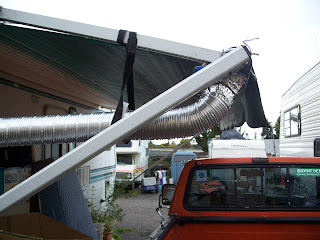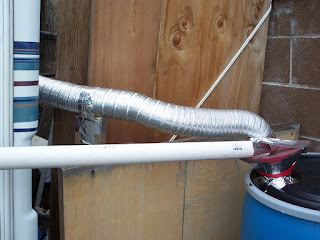After being pulled over for driving too slow, I looked up a couple hypermileing websites in order to post the story among people who might find it entertaining, and possibly offer some advice as to how to avoid/deal with the situation should it happen again. While there I found all sorts of ideas and suggestions I hadn't thought of and decided to attempt to make the truck itself more efficient to compliment my new driving style. This number is totally arbitrary and baseless, but my "goal" is 25mpg.
The average fuel economy of all US passenger cars on the road (not trucks, SUVs, or vans) is only 22.
The overall mileage for all US passenger vehicles on the road is only 17 - less than I am getting currently.
(And that's "passenger" vehicles. Technically my 5500lb diesel is classified as a commercial vehicle, even if I didn't use it for work)
Of course this whole exercise is more just for the principal than it is to save money, considering how much I spent on the project so far.
Completed so far:
-I built some homemade wheel "skirts" (wheel-well covers) to improve aerodynamics. The current ones, intended just as a test (though I may keep them as is if they work well enough and hold up) is made of cardboard (the box my new computer came in), coated in layers of aluminum tape, and then painted and edged with velcro. I lined the wheel well with velcro, and stuck 'em together, then taped over the seams with clear tape to cover the gaps of a less than perfect measuring and cutting job.
-I taped over about half of the grill (the engine runs too cold as it is) and the front turn signals to improve the aerodynamics of the front which stock basically looks like a multifaceted scoop designed to catch as much air as possible.[tape has since been replaced with coroplast sheet]
-The headlights come in a little scoop too, but since it's vital that the light not be interfered with, instead of tape I had covers custom cut out of thin Lexan plastic, which is totally clear, scratch resistant, flexible, and nearly indestructible (the same stuff my custom motorcycle windshield is made from). I traced the headlights and brought the tracing to Tap plastics who were able to cut them for me in about 5 minutes. I drilled holes in the corners and screwed them onto the grill so I can easily remove them if a headlight burns out.
-I ordered extra bright LED bulbs for the taillights and tun signals. They are brighter than stock but draw less power. The parking/brake/signal lights together use more power than the headlights, at 63 watts (parking) to 177 watts (brake) stock. The LEDs total 5.5 to 20 watts. This power is generated by the alternator, which is powered by the engine, so any reduction in electric draw ultimately reduces drain on the engine.
(while the incandescent - left - fills the lens more uniformly, the led - right - is so bright it lights up the surroundings and the edge of the tailgate)
(the difference is even more dramatic when the brakes/signals are applied)
-The dash lights alone used 15 watts. When I took apart the dash and instrument gauge, I discovered that the original system deliberately blocked and wasted the majority of light the bulbs put out by covering them with a slightly translucent cover, and then shielding the gauges on 3 sides. Which explained why the dash was always so dim. I broke off the filters, cut away the plastic shielding, and instead built reflectors (out of the same metal tape as my new rain gutters) to direct the tiny amount of light of my new bulbs on to the gauges. The result is far brighter than it was, and is all red which is easier on night vision (plus it looks really cool). I also added a voltmeter where there was an empty space before (where a tach would be on higher end models) so I can monitor the batteries if I decide to build in an alternator cut off switch

While I was working in the dash, I accidentally snapped the end of off the speedometer needle. It was extremely brittle, and as I tried to repair it, I ended up breaking off the rest. I replaced it using a match stick broken in half with a sewing needle stuck in the end, glued and taped to the post where the old needle went. I choose a needle with an orange ball on the end to match the truck. I drove past a couple "your speed is" automatic radar signs to roughly calibrate it.
I had been thinking about making a buzzer to remind me if I left the lights on, but then it occurred to me that there is really no situation where I need the lights on and don't have the keys, so while I had the dash apart I also rewired the headlights (and aux driving lights which I also just installed) so that they go off when the key is turned off so that I can't possibly accidentally leave them on and drain the battery (which would be pretty bad if I'm running sans alternator).
-I installed a tonneau cover which, in addition to increasing the trucks aerodynamics, will keep small loads clean, dry, and protected, making it a (semi)legitimate business expense. [this was later put on wood triangle rails, to tilt it to be even more aerodynamic]
-I also ordered an air compressor - the one I had wasn't nearly powerful enough for my trucks large high pressure tires. The portable Viair which runs off the truck battery, actually fills my tires faster than any gas station or mechanic compressor I've encountered. In addition to the valve caps with built in gauges I installed, this should help me keep my chronically underinflated tires up to standard.
(the valve cap turns red when tire pressure drops)
-Perhaps most important of all, I ordered a couple bumper stickers to explain to people behind me why I am driving so slow. Hopefully this should encourage people to pass, possibly inspire a few people to slow down themselves, and maybe even decrease the likelihood of future breathalyzer tests.
Future ideas include:
-Wiring in a engine kill switch and push button start. While this won't make a direct difference, it would allow me to start and stop the engine faster and easier (they would be mounted to the shift lever) without wearing out my ignition switch which will make coasting downhill and killing it at stoplights much more convenient.
[did it!]
-Replacing the power steering system with a manual steering gear. My steering box is worn out and needs replacing anyway, so this may actually save money upfront (it should be cheaper) as well as reducing the drain on the engine by allowing me to remove the power steering pump altogether.
[did it!!]
-Wiring in a switch to prevent the alternator from charging. I would then charge the large dual batteries at home each day. As long as I stayed with in the reserve capacity of the large dual batteries, I could run all electric systems off of grid power instead of fuel, but if I ran low I could always turn the alternator on (the power drain of the alternator can be as high as 1 to 2 horsepower)
[did it!!!]
-Replacing the stock hydraulic-clutch engine driven cooling fan with an electric fan which shuts off completely when its not needed (which is most of the time) moving one more engine draw to grid power (it would kind of make the truck a plug-in hybrid of sorts)
[did it!!!!]
-Replacing the 3speed transmission with one with overdrive. They were used in later years of the same truck, and so used ones that fit perfectly are available, and from what I read, I think I could do the labor myself. With the current high gear, optimal speed is only about 35mph, and considering the experience I wrote about recently...
[did it!!!!!]
I have wanted a 5speed ever since I got this truck, but even used they go for $400 or more. It would take a lot of tanks of fuel to justify that.
On the other hand, by my calculations based on made up numbers (ie, assuming I can get 25mpg out it), I should get around 190 miles more out of each tank compared to before I first heard of hypermiling.
The 500 miles I'd get out each tank would require $75 worth of biodiesel, (currently a little under $4/gallon) instead of the $125 at the old 15mpg or $100 at my current 20mpg. 500 miles is (very roughly) how far I go in a month, saving me $50 a month.
So, now that I actually work out the calculations here, for this blog entry, it seems I may hypothetically make back what i spent in a fairly reasonable amount of time afterall. If I keep this job long enough (and I have no plans to stop in the foreseeable future) that 5speed just might be worth it too.
[wrote about the install process here:
http://biodieselhauling.blogspot.com/2012/07/adding-overdrive-bw-t-19-to-zf-5.html ]





















